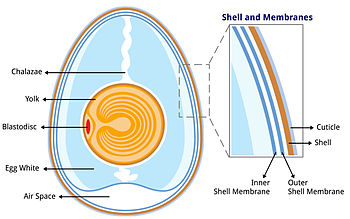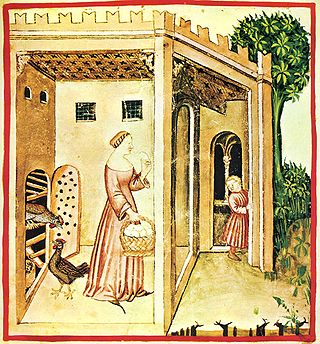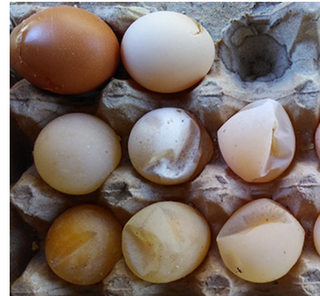
An eggshell is the outer covering of a hard-shelled egg and of some forms of eggs with soft outer coats.

An eggshell is the outer covering of a hard-shelled egg and of some forms of eggs with soft outer coats.
Nematode eggs present a two layered structure: an external vitellin layer made of chitin that confers mechanical resistance and an internal lipid-rich layer that makes the egg chamber impermeable. [1]

Insects and other arthropods lay a large variety of styles and shapes of eggs. Some of them have gelatinous or skin-like coverings, others have hard eggshells. Softer shells are mostly protein. It may be fibrous or quite liquid. Some arthropod eggs do not actually have shells, rather, their outer covering is actually the outermost embryonic membrane, the choroid, which protects inner layers. This can be a complex structure, and it may have different layers, including an outermost layer called an exochorion. Eggs which must survive in dry conditions usually have hard eggshells, made mostly of dehydrated or mineralized proteins with pore systems to allow respiration. Arthropod eggs can have extensive ornamentation on their outer surfaces.[ citation needed ]
Fish and amphibians generally lay eggs which are surrounded by the extraembryonic membranes but do not develop a shell, hard or soft, around these membranes. Some fish and amphibian eggs have thick, leathery coats, especially if they must withstand physical force or desiccation. These types of eggs can also be very small and fragile.[ citation needed ]
While many reptiles lay eggs with flexible, calcified eggshells, there are some that lay hard eggs. Eggs laid by snakes generally have leathery shells which often adhere to one another. Depending on the species, turtles and tortoises lay hard or soft eggs. Several species lay eggs which are nearly indistinguishable from bird eggs.[ citation needed ]


The bird egg is a fertilized gamete (or, in the case of some birds, such as chickens, possibly unfertilized) located on the yolk surface and surrounded by albumen, or egg white. The albumen in turn is surrounded by two shell membranes (inner and outer membranes) and then the eggshell. The chicken eggshell is 95[ citation needed ]-97% [2] calcium carbonate crystals, which are stabilized by a protein matrix. [3] [4] [2] Without the protein, the crystal structure would be too brittle to keep its form and the organic matrix is thought to have a role in deposition of calcium during the mineralization process. [5] [6] [7] The structure and composition of the avian eggshell protects the egg from damage and microbial contamination, prevents desiccation, regulates embryonic gas and water exchange and provides calcium for embryogenesis. Eggshell formation requires gram amounts of calcium being deposited within hours, which must be supplied via the hen's diet. [2] The avian eggshell is constructed from an organized assembly of mineral nanoparticles whose size confers different hardness properties to different regions of the shell. [8]


The fibrous chicken shell membranes are added in the proximal (white) isthmus of the oviduct. [2] In the distal (red) isthmus mammillae or mammillary knobs are deposited on the surface of the outer membrane in a regular array pattern. [9] [10] The mammillae are proteoglycan-rich and are thought to control calcification. In the shell gland (similar to a mammalian uterus), mineralization starts at the mammillae and around the outermost membrane fibers. [11] The shell gland fluid contains very high levels of calcium and bicarbonate ions. The thick calcified layer of the eggshell forms in columns from the mammillae structures, and is known as the palisade layer. Between these palisade columns are narrow pores that traverse the eggshell and allow gaseous exchange. The cuticle forms the final, outer layer of the eggshell. [12] Attachment of the soft organic fibrous membrane to the hard calcite shell is essential for proper chick embryonic development and growth (via ensuring association of the chorioallantoic membrane, and in allowing for air-sac formation at the blunt end of the egg). This attachment between dissimilar materials is facilitated by a structural interdigitation of fibers into each mammillae at the microscale, and reciprocally, at the nanoscale, mineral spiking into fibers directly at the interface [11]
While the bulk of eggshell is made of calcium carbonate, it is now thought that the protein matrix has an important role to play in eggshell strength. [13] These proteins affect crystallization, which in turn affects the eggshell structure. The concentration of eggshell proteins decreases over the life of the laying hen, as does eggshell strength.[ citation needed ]
In an average laying hen, the process of shell formation takes around 20 hours. Pigmentation is added to the shell by papillae lining the oviduct, coloring it any of a variety of colors and patterns depending on species. Since eggs are usually laid blunt end first, that end is subjected to most pressure during its passage and consequently shows the most color.[ citation needed ]
As they contain mainly calcium carbonate, bird eggshells dissolve in various acids, including the vinegar used in cooking. While dissolving, the calcium carbonate in an eggshell reacts with the acid to form carbon dioxide. [14]
The US food industry generates 150,000 tons of shell waste per year. [15] The disposal methods for waste eggshells are 26.6% as fertilizer, 21.1% as animal feed ingredients, 26.3% discarded in municipal dumps, and 15.8% used in other ways. [16] Many landfills are unwilling to take the waste because the shells and the attached membrane attract vermin.[ citation needed ] When unseparated, the calcium carbonate eggshell and protein-rich membrane are useless. [17] Recent inventions have allowed for the egg cracking industry to separate the eggshell from the eggshell membrane. The eggshell is mostly made up of calcium carbonate and the membrane is valuable protein. When separated both products have an array of uses.[ citation needed ]
Monotremes, egg-laying mammals, lay soft-shelled eggs similar to those of reptiles. The shell is deposited on the egg in layers within the uterus. The egg can take up fluids and grow in size during this process, and the final, most rigid layer is not added until the egg is full-size.[ citation needed ]
Hatching birds, amphibian and egg-laying reptiles have an egg-tooth used to start an exit hole in the hard eggshell. [18] [19]
Eggshell waste is fundamentally composed of calcium carbonate, and has the potential to be used as raw material in the production of lime. [20]
The rich calcium carbonate shell has been used in the application for calcium deficiency therapies in humans and animals. [16] [21] A single eggshell has a mass of six grams which yields around 2200 mg of calcium (6000 mg × 0.95 × 0.4= 2280 mg). Eggshell particles are used in toothpaste as an anti-tartar agent. [16] Powdered eggshells have been used for bone mineralization and growth. [16] [22] [21]
Recent applications of eggshells include producing calcium lactate as a firming agent, a flavor enhancer, a leavening agent, a nutrient supplement, a stabilizer, and thickener. [16] [21] Eggshells are also used as a calcium supplement in orange juice. [15]
Eggshells have been incorporated into fertilizers as a soil conditioner. [16] [23] They have also been used as a supplement to animal feed. [16] [23] More recently the egg calcium carbonate particles have been used as coating pigments for ink-jet printing. [23] Powdered eggshells are also used in making paper pulp. [15] Recently eggshell waste has been used as a low cost catalyst for biodiesel production. [22] Chicken eggshells have been additionally incorporated as a calcium precursor into the synthesis of calcium-based metal-organic frameworks (MOFs). [24]
Recently, researchers have utilized chicken eggshells as a biofiller with a conducting polymer to enhance its sensing properties. Typically, eggshells were used as biofiller in polyaniline matrix to detect ammonia gas. The optimum ratio between eggshells and polyaniline could enhance this sensor measurement. [25]
Ostrich eggshells have been used by Sub Saharan hunter-gathers. For instance the Juǀʼhoansi have used them to carry water [26] and create beads from them. [27]

The chicken or the egg causality dilemma is commonly stated as the question, "which came first: the chicken or the egg?" The dilemma stems from the observation that all chickens hatch from eggs and all chicken eggs are laid by chickens. "Chicken-and-egg" is a metaphoric adjective describing situations where it is not clear which of two events should be considered the cause and which should be considered the effect, to express a scenario of infinite regress, or to express the difficulty of sequencing actions where each seems to depend on others being done first. Plutarch posed the question as a philosophical matter in his essay "The Symposiacs", written in the 1st century CE.

Nacre, also known as mother of pearl, is an organic–inorganic composite material produced by some molluscs as an inner shell layer. It is also the material of which pearls are composed. It is strong, resilient, and iridescent.

Among animals which produce eggs, the yolk is the nutrient-bearing portion of the egg whose primary function is to supply food for the development of the embryo. Some types of egg contain no yolk, for example because they are laid in situations where the food supply is sufficient or because the embryo develops in the parent's body, which supplies the food, usually through a placenta. Reproductive systems in which the mother's body supplies the embryo directly are said to be matrotrophic; those in which the embryo is supplied by yolk are said to be lecithotrophic. In many species, such as all birds, and most reptiles and insects, the yolk takes the form of a special storage organ constructed in the reproductive tract of the mother. In many other animals, especially very small species such as some fish and invertebrates, the yolk material is not in a special organ, but inside the egg cell.

An egg is an organic vessel grown by an animal to carry a possibly fertilized egg cell and to incubate from it an embryo within the egg until the embryo has become an animal fetus that can survive on its own, at which point the animal hatches.

Egg incubation is the process by which an egg, of oviparous (egg-laying) animals, develops an embryo within the egg, after the egg's formation and ovipositional release. Egg incubation is done under favorable environmental conditions, possibly by brooding and hatching the egg.

Conchiolins are complex proteins which are secreted by a mollusc's outer epithelium.
The vitelline membrane or vitelline envelope is a structure surrounding the outer surface of the plasma membrane of an ovum or, in some animals, the extracellular yolk and the oolemma. It is composed mostly of protein fibers, with protein receptors needed for sperm binding which, in turn, are bound to sperm plasma membrane receptors. The species-specificity between these receptors contributes to prevention of breeding between different species. It is called zona pellucida in mammals. Between the vitelline membrane and zona pellucida is a fluid-filled perivitelline space.

Bird eggs are laid by the females and range in quantity from one to up to seventeen. Clutch size may vary latitudinally within a species. Some birds lay eggs even when the eggs have not been fertilized; it is not uncommon for pet owners to find their lone bird nesting on a clutch of infertile eggs, which are sometimes called wind-eggs.

The molluscshell is typically a calcareous exoskeleton which encloses, supports and protects the soft parts of an animal in the phylum Mollusca, which includes snails, clams, tusk shells, and several other classes. Not all shelled molluscs live in the sea; many live on the land and in freshwater.

Dinosaur eggs are the organic vessels in which a dinosaur embryo develops. When the first scientifically documented remains of non-avian dinosaurs were being described in England during the 1820s, it was presumed that dinosaurs had laid eggs because they were reptiles. In 1859, the first scientifically documented dinosaur egg fossils were discovered in France by Jean-Jacques Poech, although they were mistaken for giant bird eggs.

Humans and their hominid ancestors have consumed eggs for millions of years. The most widely consumed eggs are those of fowl, especially chickens. People in Southeast Asia began harvesting chicken eggs for food by 1500 BCE. Eggs of other birds, such as ducks and ostriches, are eaten regularly but much less commonly than those of chickens. People may also eat the eggs of reptiles, amphibians, and fish. Fish eggs consumed as food are known as roe or caviar.

The insect vitelline envelope is the outer proteinaceous layer outside the oocyte and egg. The vitelline envelope, not being a cellular structure, is commonly referred to as a membrane. However, this is a technical misnomer as the structure is composed of protein and is not a cellular component. It varies in thickness between different insects and even varies at different parts of the egg. It lies inside the outer shell of the egg, which is commonly referred to as the chorion.

The chorioallantoic membrane (CAM), also known as the chorioallantois, is a highly vascularized membrane found in the eggs of certain amniotes like birds and reptiles. It is formed by the fusion of the mesodermal layers of two extra-embryonic membranes – the chorion and the allantois. It is the avian homologue of the mammalian placenta. It is the outermost extra-embryonic membrane which lines the non-vascular egg shell membrane.

Mineralized tissues are biological tissues that incorporate minerals into soft matrices. Typically these tissues form a protective shield or structural support. Bone, mollusc shells, deep sea sponge Euplectella species, radiolarians, diatoms, antler bone, tendon, cartilage, tooth enamel and dentin are some examples of mineralized tissues.
Continuoolithus is an oogenus of dinosaur egg found in the late Cretaceous of North America. It is most commonly known from the late Campanian of Alberta and Montana, but specimens have also been found dating to the older Santonian and the younger Maastrichtian. It was laid by an unknown type of theropod. These small eggs are similar to the eggs of oviraptorid dinosaurs, but have a distinctive type of ornamentation.
Eggshell membrane separation is a recycling process to separate the protein-rich eggshell membrane from the eggshell.

Egg taphonomy is the study of the decomposition and fossilization of eggs. The processes of egg taphonomy begin when the egg either hatches or dies. Eggshell fragments are robust and can often travel great distances before burial. More complete egg specimens gradually begin to fill with sediment, which hardens as minerals precipitate out of water percolating through pores or cracks in the shell. Throughout the fossilization process the calcium carbonate composing the eggshell generally remains unchanged, allowing scientists to study its original structure. However, egg fossils buried under sediments at great depth can be subjected to heat, pressure and chemical processes that can alter the structure of its shell through a process called diagenesis.

Eggshell membrane or shell membrane is the clear film lining eggshells, visible when one peels a boiled bird egg. Chicken eggshell membranes are used as a dietary supplement.

Egg drop syndrome '76 is a viral disease that affects birds, notably chickens, ducks, geese and swans. It is characterised by a sudden drop in production of eggs as well as its eggshell quality in apparent healthy laying birds.

Avimaia is a genus of fossil birds of the Enantiornithes clade that lived about 115 million years ago in Northwest China. The only known species is A. schweitzerae. The holotype fossil of the bird was found in the Xiagou Formation, and is noted as the first discovered fossil bird with an unlaid egg. Abnormalities, including egg binding in which the egg becomes stuck within the body of the bird causing death, were found in the egg suggesting that the preserved egg may have caused this bird's demise. Egg binding is a serious and lethal condition that is fairly common in small birds undergoing stress.
{{cite web}}: Missing or empty |title= (help)[ dead link ]